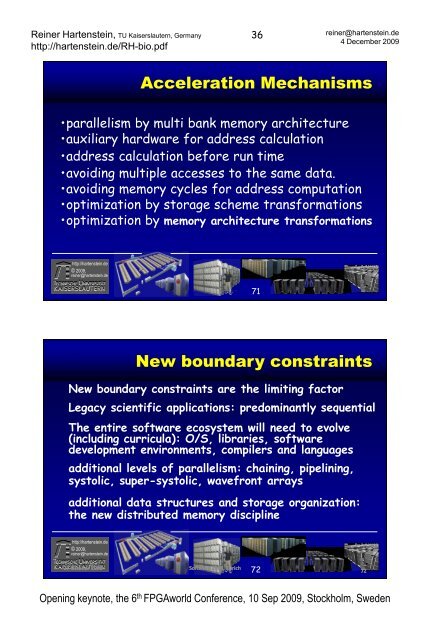software engineering - Reiner Hartenstein
software engineering - Reiner Hartenstein
software engineering - Reiner Hartenstein
You also want an ePaper? Increase the reach of your titles
YUMPU automatically turns print PDFs into web optimized ePapers that Google loves.
<strong>Reiner</strong> <strong>Hartenstein</strong>, TU Kaiserslautern, Germany<br />
http://hartenstein.de/RH-bio.pdf<br />
36<br />
reiner@hartenstein.de<br />
4 December 2009<br />
Acceleration Mechanisms<br />
•parallelism by multi bank memory architecture<br />
•auxiliary hardware for address calculation<br />
•address calculation before run time<br />
•avoiding multiple accesses to the same data.<br />
•avoiding memory cycles for address computation<br />
•optimization by storage scheme transformations<br />
•optimization by memory architecture transformations<br />
http://hartenstein.de<br />
© 2009,<br />
reiner@hartenstein.de<br />
71<br />
New boundary constraints<br />
New boundary constraints are the limiting factor<br />
Legacy scientific applications: predominantly sequential<br />
The entire <strong>software</strong> ecosystem will need to evolve<br />
(including curricula): O/S, libraries, <strong>software</strong><br />
development environments, compilers and languages<br />
additional levels of parallelism: chaining, pipelining,<br />
systolic, super-systolic, wavefront arrays<br />
additional data structures and storage organization:<br />
the new distributed memory discipline<br />
http://hartenstein.de<br />
© 2009,<br />
reiner@hartenstein.de<br />
27 October 2008 Software 2008, Zurich<br />
72<br />
72<br />
Opening keynote, the 6 th FPGAworld Conference, 10 Sep 2009, Stockholm, Sweden


